| |
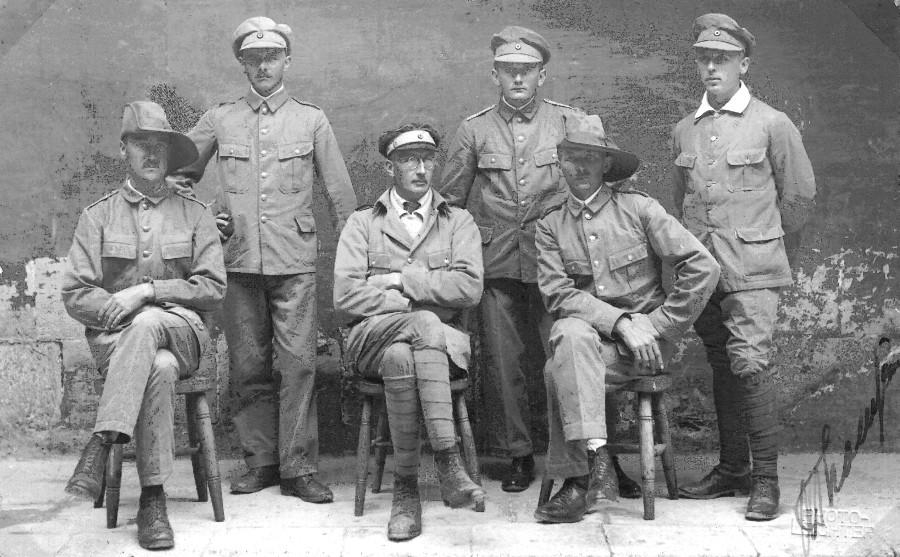
Schutztruppe POWs, Malta
c1916-18
These men all wear the 1896 Schutztruppe Khaki Uniform. The
officer seated in the centre clearly has a white hatband on
his field cap showing him to have served in East Africa. The
other two seated officers have Südwester hats with what may
be red hatbands and edging showing them to have served in
Cameroon. It is difficult to be sure of the hatband colours
of the three standing figures. The two on the left may have
white while the man on the left may have red. Most of the
men have their trousers loose over short marching boots
while two have puttees. The officer seated in the centre may
have improvised khaki puttees made in East Africa.
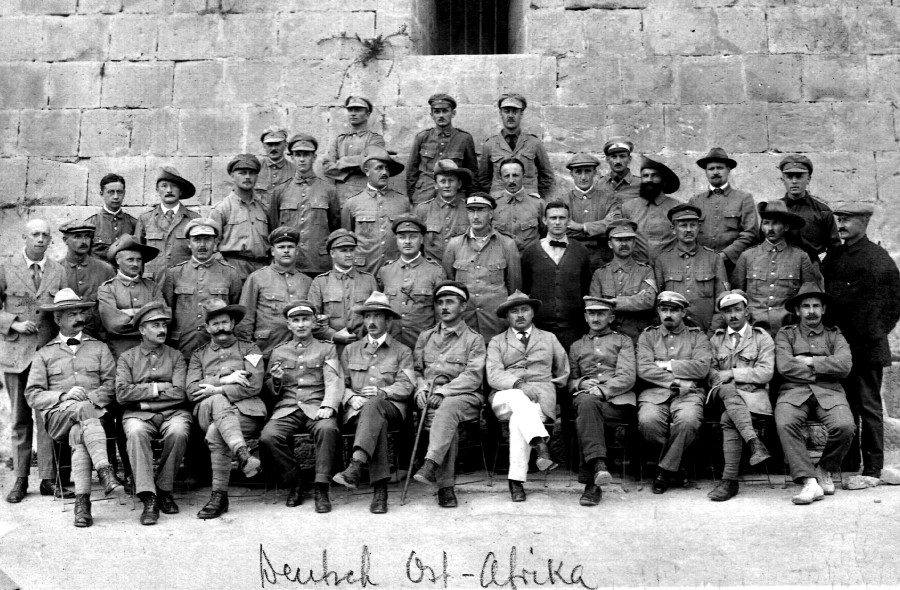
Schutztruppe POWs, Malta c1916-18
Most of these men wear the 1896 Schutztruppe Khaki Uniform. Note
some men have the East African field cap with white hatband,
while others have the Cameroon Südwester with its red hatband
and edging. The exact colour of some caps cannot be made out for
certain on all the men. Some men wear civilian clothing. In some
cases it is to replace uniform items but in other cases they may
be German civilians interned with the POWs. Note the three
Schutztruppe NCOs with the rank chevrons of a Feldwebel.
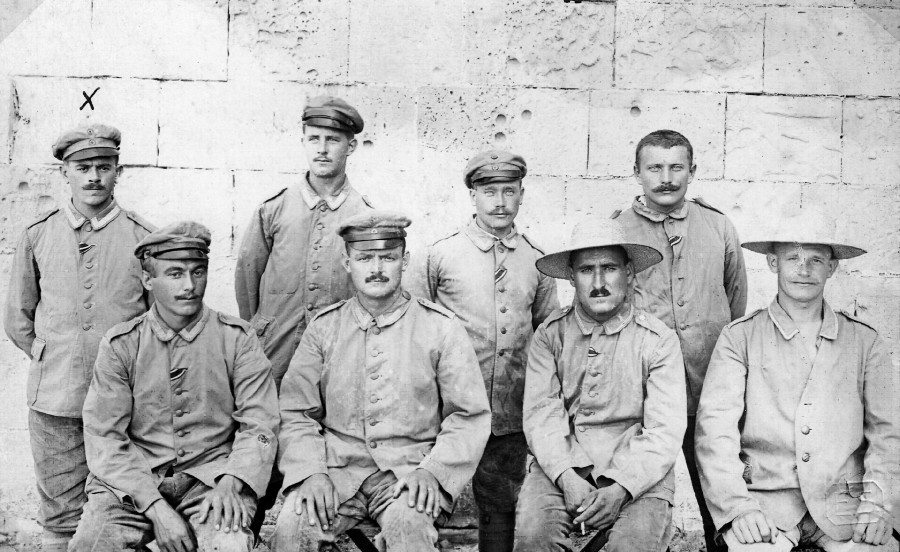 German Army NCO POWs from the Middle East, Malta
c1916-18
German Army NCO POWs from the Middle East, Malta
c1916-18
These men are wearing the 1916 Khaki Uniform worn by the German army in the
Middle East (such as the Pascha I and II Expeditions). Note the shortened rank
insignia on the collar and two cockades on their khaki field caps. Two of the
men have privately acquired straw hats.
Five of the NCOs have the Prussian Iron Cross second class ribbon worn in their
buttonholes. The seated NCO on the far left has another unidentified medal
ribbon worn under his Iron Cross.
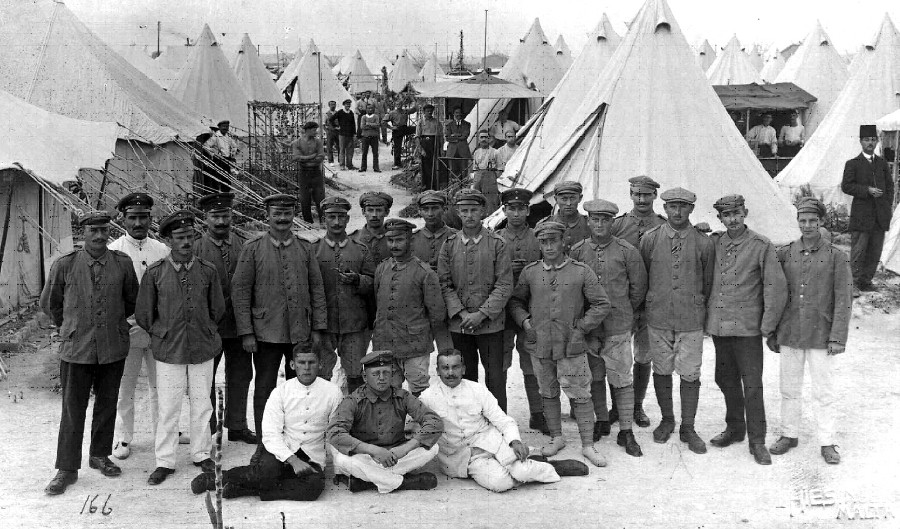
German Army NCO POWs from the Middle East, Malta
c1916-18
These men are
mostly wearing the 1916 Khaki Uniform worn by the German
army in the Middle East. Three of them have some form of white tropical uniform,
several of them have civilian flat caps. They pose in front of the tents in
which they lived.
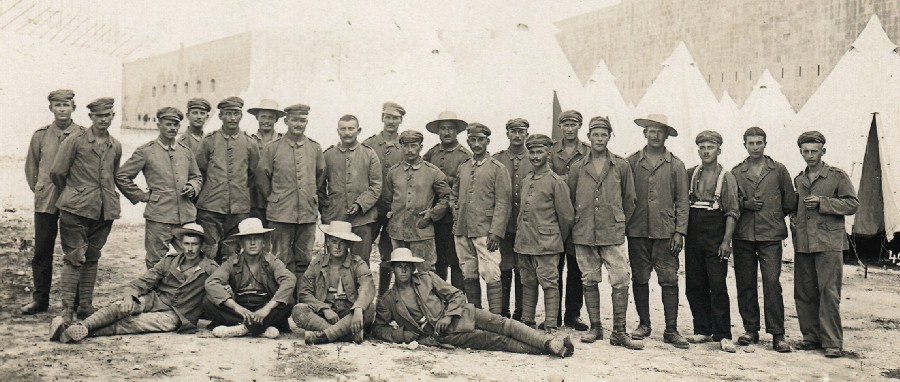
German Army NCO POWs from the
Middle East, Malta c1916-18
These men are
mostly wearing the 1916 Khaki Uniform worn by the German
army in the Middle East. Some of them have privately acquired
straw hats and other items of civilian clothing.
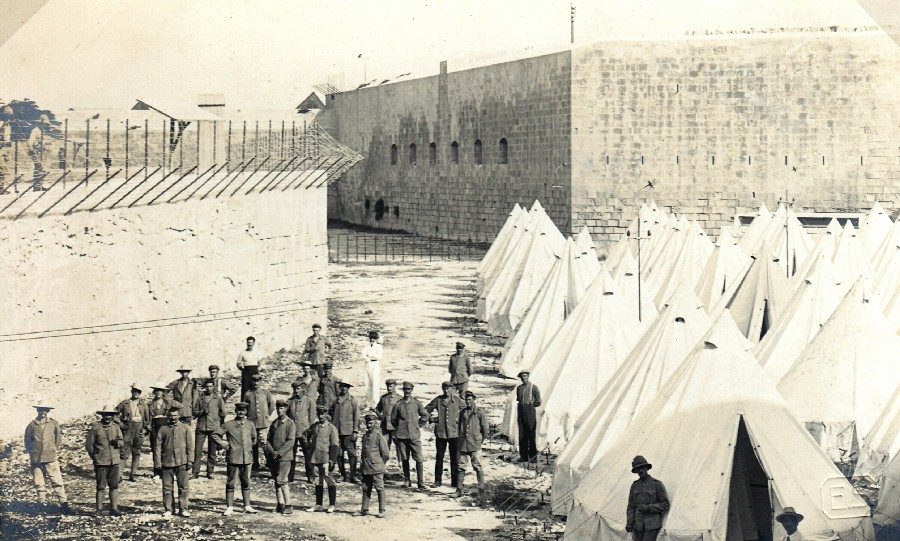
German Army NCO POWs from the
Middle East, Malta c1916-18
These men are
mostly wearing the 1916 Khaki Uniform worn by the German
army in the Middle East. Some of them have privately
acquired straw hats and other items of civilian clothing.
Note the British army guard in the right foreground with a
Wolsey Tropical Helmet. |
|
| |
|
|
A Summary of the Prisoners of War Interned at Malta 1914 -1919
The main events with PoWs arriving for
the Malta PoW Camps are summarised, together with approximate
numbers. Many of those held in Malta were civilian internees and
crews from merchant ships. Large numbers were transferred to Malta
from Egypt. Each PoW was allocated a Malta PoW Number on arrival and
these are shown in groups corresponding to the date range and main
events.
|
Period |
Main Events |
PoWs |
PoW Nos. |
|
Aug-Oct14 |
Local internees + ships’ crews from
Erymanthos and Kawak |
99 by 22Aug14 |
1-150 |
|
Nov14 |
1st batch of German & Austrian
internees from Egypt (arrived 4.11), including ship’s crew
from Koerber |
597 |
150-770 |
|
Ottomans received from French Navy (6.11)
|
19 |
|
Dec14 |
2nd batch of Germans &
Austrians from Egypt (1.12) |
564 |
770-1570 |
|
German Navy Survivors from SMS Emden
(6.12) |
150 |
|
3rd batch of Germans,
Austrians & Turks from Egypt (20.12) |
75 |
|
Jan-Jul15 |
Ottomans received from French (23.2) |
15 |
1570-1710 |
|
Crews of Gutenfels and Marquis
Bacquehem from Egypt |
60 |
|
Aug-Dec15 |
Bulgarian ship’s crew |
16 |
1710-1885 |
|
Greeks from Salonika |
30 |
|
Jugoslavs & Ottomans from Egypt |
45 |
|
Jan- Jun16 |
Greeks from Salonika |
40 |
1885-1985 |
|
Ottomans from Egypt |
35 |
|
Jul-Dec16 |
German soldiers captured in Palestine via
Egypt |
24 |
1985- 2140 |
|
Ottomans from Hedjaz and Egypt |
60 |
|
Jan- Jun17 |
Ottomans from Egypt |
100 |
2140- 2245 |
|
Jul- Dec17 |
German and Austrian soldiers captured in
Africa via Egypt |
152 |
2245-2425 |
|
Jan-Jun18 |
German Navy Survivors from SMS Breslau |
93 |
2425-2530 |
|
Jul-Nov18 |
German Navy Survivors from U-boat UB-53 |
27 |
2530-2650 |
|
Ottomans from Egypt |
40 |
|
German Navy Survivors from U-boat UB-68 |
33 |
|
After Nov18 |
Just over twenty more PoWs received,
including General Liman von Sanders, up to end-August 1919.
There was a slight overlap with the post-WW1 Turkish
Deportees, with the non-Turkish filling the gaps after PoW
No.2668. |
20 |
2650-2666 + later gaps |
The Return
of the PoWs after the War
Although there were some departures
during the First World War, the majority remained in situ until the
respective Peace Treaties had been signed and even then, individual
departures still required suitable transport, transit visas and funds.
The majority of PoWs were not
able to pay their own way and it was the responsibility of the respective
National Governments to provide transportation for their prisoners homeward
journeys. Germany in
particular suffered from a massive shortage of shipping and this delayed
German PoW departures from Malta. Although the Treaty of Versailles was
signed on 28th June 1919, it wasn't until November 1919 that suitable
transport had been acquired. Some 1200 German PoWs departed Malta during
that month on SS Reshid Pasha.
In contrast, the first Austrians
departed on 10th September 1919, the day the Peace Treaty of Saint Germain-en-Laye was signed. 30 departed that day on SS Etruria,
followed by 33 a week later on SS Citta di Tripoli. Unfortunately,
the detailed information held at Kew Records Office doesn't continue beyond
the end of September
1919, although it's understood that the Austrians had all departed by
November.
Thanks to Alan Green
for sharing this information and these photos with us. Please
respect his generosity by not reproducing them elsewhere without
permission.
Photos ©
Malta Study Circle
Please
contact me here if you have other photographs of the
German colonies or the soldiers and sailors that served there. I am especially
keen to hear from people with family photograph collections and am always happy
to try to assist in identifying uniforms, units, places and dates for family history
research.
Back to
Main Menu for German Colonial Uniforms
|